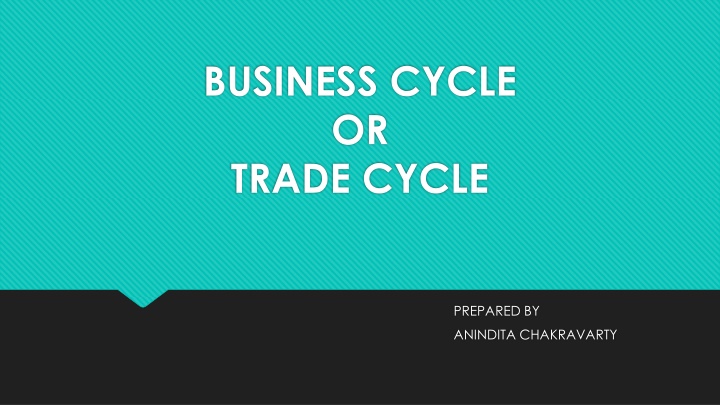
Trade Cycles in Economics
Explore the meaning, features, and importance of trade cycles in economics, including their impact on employment and consumer demand. Learn about the phases and characteristics of trade cycles as described by prominent economists.
Download Presentation

Please find below an Image/Link to download the presentation.
The content on the website is provided AS IS for your information and personal use only. It may not be sold, licensed, or shared on other websites without obtaining consent from the author. If you encounter any issues during the download, it is possible that the publisher has removed the file from their server.
You are allowed to download the files provided on this website for personal or commercial use, subject to the condition that they are used lawfully. All files are the property of their respective owners.
The content on the website is provided AS IS for your information and personal use only. It may not be sold, licensed, or shared on other websites without obtaining consent from the author.
E N D
Presentation Transcript
BUSINESS CYCLE OR TRADE CYCLE PREPARED BY ANINDITA CHAKRAVARTY
Meaning of Trade Cycle: A trade cycle refers to fluctuations in economic activities specially in employment, output and income, prices, profits etc. It has been defined differently by different economists. According to Mitchell, Business cycles are of fluctuations in the economic activities of organized communities. The adjective business restricts the concept of fluctuations in activities which are systematically conducted on commercial basis. The noun cycle bars out fluctuations which do not occur with a measure of regularity . According to Keynes, A trade cycle is composed of periods of good trade characterised by rising prices and low unemployment percentages altering with periods of bad trade characterised by falling prices and high unemployment percentages .
Features of a Trade Cycle: A business cycle is synchronic. When cyclical fluctuations start in one sector it spreads to other sectors. In a trade cycle, a period of prosperity is followed by a period of depression. Hence trade cycle is a wave like movement. Business cycle is recurrent and rhythmic; prosperity is followed by depression and vice versa. A trade cycle is cumulative and self-reinforcing. Each phase feeds on itself and creates further movement in the same direction
o CONTD o A trade cycle is asymmetrical. The prosperity phase is slow and gradual and the phase of depression is rapid. o The business cycle is not periodical. Some trade cycles last for three or four years, while others last for six or eight or even more years. o The impact of a trade cycle is differential. It affects different industries in different ways. o A trade cycle is international in character. Through international trade, booms and depressions in one country are passed to other countries
Importance of Business Cycle Employment: The business cycle has major implications on the total level of employment in the economy. During periods of economic growth and prosperity, employment tends to be high because businesses need more workers to meet demand and expand their companies. On the other hand, economic downturns and recessions tend to be characterized by rising unemployment, cuts in worker hours and cuts in worker pay. Consumer Demand: One of the primary reasons the business cycle is important to businesses is that it can have a significant influence on consumer demand. High levels of unemployment and underemployment mean consumers have less money to spend on products and services, which tends to reduce consumer demand. Low consumer demand leads to lower sales for businesses, which shrinks profits and increases the chances of suffering losses. Companies that suffer sustained losses may be forced out of the market.
Phases of a Trade Cycle: Generally, a trade cycle is composed of four phases depression, recovery, prosperity and recession. Lets discuss them one by one with diagram
Depression During depression, the level of economic activity is extremely low. Real income production, employment, prices, profit etc. are falling. There are idle resources. Price is low leading to a fall in profit, interest and wages. All the sections of the people suffer. During this phase, there will be pessimism leading to closing down of business firms.
Recovery Recovery denotes the turning point of business cycle form depression to prosperity. In this phase, there is a slow rise in output, employment, income and price. Demand for commodities go up. There is increase in investment, bank loans and advances. Pessimism gives way to optimism. The process of revival and recovery becomes cumulative and leads to prosperity.
Prosperity: It is a state of affairs in which real income and employment are high. There are no idle resources. There is no wastage of materials. There is rise in wages, prices, profits and interest. Demand for bank loans increases. There is optimism everywhere. There is a general uptrend in business community.
Contd. However, these boom conditions cannot last long because the forces of expansion are very weak. There are bottlenecks and shortages. There may be scarcity of labour, raw material and other factors of production. Banks may stop their loans. These conditions lead to recession.
Recession: When the entrepreneurs realize their mistakes, they reduce investment, employment and production. Then fall in employment leads to fall in income, expenditure, prices and profits. Optimism gives way to pessimism. Banks reduce their loans and advances. Business expansion stops. This state of recession ends in depression.
